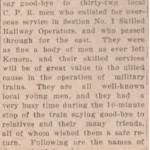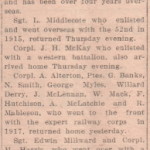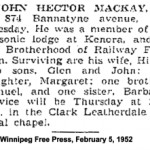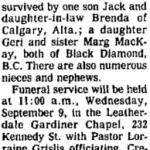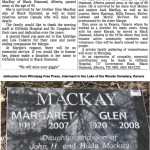
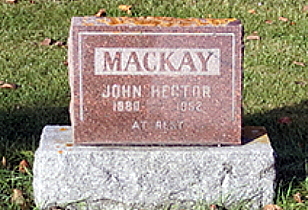
| Personal Details | |
| Date of Birth | August 8, 1880 |
| Place of Birth | Liverpool |
| Country | England |
| Marital Status | Married |
| Next of Kin | Hilda MacKay, wife, 536 3rd Street South, Kenora, Ontario |
| Trade / Calling | Locomotive Engineer |
| Religion | Presbyterian |
| Service Details | |
| Regimental Number | 2125021 |
| Service Record | Link to Service Record |
| Battalion | No 58 Broad Gauge Railway Operating Company |
| Force | Canadian Expeditionary Force |
| Branch | Canadian Railway Troops |
| Enlisted / Conscripted | Enlisted |
| Date of Enlistment | February 3, 1917 |
| Age at Enlistment | 36 |
| Theatre of Service | Europe |
| Prisoner of War | No |
| Survived War | Yes |
| Death Details | |
| Date of Death | February 5, 1952 |
| Age at Death | 71 |
| Buried At | Brookside Cemetery, Winnipeg, Manitoba |
| Plot | 49-0696-0 |
MacKay, John Hector
John Hector MacKay was born on 8 August 1880 in Kirkdale, Liverpool, England. His father John Hector MacKay was from Scotland and by the time of the 1871 census was boarding in the Samuel and Ann (née Watt) Neish household in Everton, Liverpool, occupation listed as engine driver. On 16 October 1975 in Walton-on-the-Hill, Liverpool, John married Ann Neish, daughter of Samuel and Ann. At the time of the marriage John’s occupation was given as marine engineer. The next year the couple gave birth to daughter Barbara, followed by son Samuel in 1878, and John Jr in 1880. It appears that John Sr died during the first quarter of 1882. Barbara was raised by her maternal grandmother Ann while Samuel, age 8, was sent to Canada in 1885, arriving in Montreal on 10 November aboard the Polynesian.
John’s mother Ann married widower Thomas Coburn, a mariner, on 13 May 1883 in Liverpool. Thomas had previously been married to Jane Parker who had died in 1882, leaving behind a number of children. Together Ann and Thomas gave birth to five children, William Henry (1885), Annie Watt (1887), Christina (1889), Thomasina (1891), and Alexander (1893). Thomas died in 1897 followed by Ann in 1900. Coming from the Liverpool Sheltering Home and along with a number of other children, William, Annie, Christina, and Thomasina arrived in Canada aboard the Vancouver on 17 May 1900, on their way to the Louisa Birt House in Knowlton, Quebec. Alexander, coming from the Liverpool Workhouse, arrived in Canada with a party of Barnardo children in February of 1902 aboard the Dominion. ‘Between 1869 and the late 1930s, over 100,000 juvenile migrants were sent to Canada from the British Isles during the child emigration movement. Motivated by social and economic forces, churches and philanthropic organizations sent orphaned, abandoned and pauper children to Canada. Many believed that these children would have a better chance for a healthy, moral life in rural Canada, where families welcomed them as a source of cheap farm labour and domestic help. After arriving by ship, the children were sent to distributing and receiving homes, and then sent on to farmers in the area. Although many of the children were poorly treated and abused, others experienced a better life here than if they had remained in the urban slums of England. Many served with the Canadian and British Forces during both World Wars.’ (Library and Archives Canada)
Although it is possible that John too was sent to Canada as a British Home child, it is likely that he immigrated to Canada in 1903, arriving in Montreal aboard the Sardinian on June 23. On the passenger list his place of origin was given as Fife in Scotland, occupation was listed as fireman, and his destination as Winnipeg. His brother Samuel had eventually settled in Winnipeg and after the Mariaggi Hotel was built in 1903 he became the proprietor. He was also involved in real estate and insurance businesses in the city. By the time of the 1911 census John was lodging with the Edward Riley family on 5th Avenue South in Kenora, Ontario and working as a fireman for the Canadian Pacific Railway. It appears that John was not at home at the time of the census, his date of birth missing and place of birth given as Scotland.
On 12 May 1912, in Kenora, John married Hilda Schultz. According to her obituary Hilda was born on 16 November 1890 in Rat Portage (later renamed Kenora), but it is likely that she was born in Russia or Poland and immigrated to Canada with her parents William Schultz and Amelia Bischke around 1894. At the time of the marriage John was working as an engineer and Hilda as a maid. Witnesses at the marriage were John’s neighbours from 5th Avenue South, James and Ethel Sherman. John and Hilda made Kenora their home, giving birth to children Margaret (1912), Jean (1913-1914), John Hector (1915), Douglas (1916-1916), and after the war, Glen Raymond (1920).
John signed his attestation papers in Winnipeg, Manitoba on 3 February 1917, occupation given as locomotive engineer and next of kin his wife Hilda in Kenora. A Kenora newspaper article of the seventh of February spoke of John, along with 31 other Kenora men that had signed up for overseas service with the No 1 Skilled Railway Employees, passing through Kenora heading east on the first leg of the journey to the front.
Listed as a Private on the nominal rolls of the No 1 Section, Skilled Railway Employees, John embarked from Halifax aboard the Ausonia on 4 March 1917. Once in England he was promoted to 2nd Corporal on the 23rd of March. First redesignated as the 12th (Canadian) Light Railway Operating Company, Royal Engineers that March, the unit was changed to the No 58 Broad Gauge Railway Operating Company (Canadians) Royal Engineers on April 7th, arriving in France on April 19th. ‘This unit was operating lines in the immediate rear of active operations and hauled troops, ammunition, supplies, material, ambulance trains, refugees for the battles of Messines Ridge, June 1917, and the Lys, April 1918.’ (Library and Archives Canada). A description of some of the activities of the 58th Broad Gauge Operation Company was summarized in the Canadian Rail’s November December 1993 edition that marked the 75th anniversary of the end of the war: ‘The Canadian Railway Troops on World War 1’.
John was granted two leaves during his service, the first for two weeks to the UK in July of 1918, and the second for nine days in France in mid February of 1919. In mid April of 1919 he proceeded to England and on the 14th of May he embarked for Canada on the first leg of his journey back to Kenora. John was discharged from service on 27 May 1919 in Montreal. A Kenora newspaper reported his return as well as the return of his former landlord Edward Riley who had served with the Canadian Forestry Corps in England during the last two years of the war.
Living in Winnipeg and working as a hotel inspector, John’s brother Samuel signed his attestation papers with the 107th Battalion in January of 1915. In 1917 he signed Officer’s papers at Camp St Charles, occupation given as commission agent, and previous service as with the 79th, 107th and 197th Battalions. As a Lieutenant with the 2nd Independent Infantry Company he arrived in Liverpool aboard the Metagama on 17 October 1917. Further details of his service are unknown. John’s half brother Alexander Coburn enlisted in Montreal in June of 1917, giving his sister Thomasina (Ena) Hawkins of Montreal as next of kin. Alexander served overseas with the 5th Canadian Mounted Rifles, hospitalized for gassing in August of 1918 and suffered a gunshot/shrapnel wound to the leg on 8 November 1918 causing him to be invalided to England. After a bout of influenza in March of 1919, Alexander returned to Canada in late June 1919.
After the war John resumed working as an engineer for the Canadian Pacific Railway out of Kenora. As evidenced by a 1935 Voters list, the family relocated to Winnipeg, making their home at 874 Bannatyne Avenue. John died on 5 February 1952 and is interred in Brookside Cemetery in Winnipeg. At the time of his death he was survived by his wife Hilda, daughter Margaret, sons John and Glen, brother Samuel in Winnipeg and sister Barbara back in England. After John’s death Hilda moved back to Kenora where she died on 8 March 1975. Along with daughter Margaret (d 2007) and son Glen (d 2008) as well as the children that died in infancy, she is interred in the Lake of the Woods Cemetery in Kenora. John’s sister Barbara died in 1957 in Liverpool and his brother Samuel in 1960 in Winnipeg who is also interred in Brookside Cemetery. Son John died in Winnipeg in 1981, survived by his wife Gwen, son Jack and family, and daughter Geri. According to his obituary he had served overseas during WW2 with the RCAF.
It is not known if John had contact with his half siblings that were sent to Canada as British Home children. William married Emily Jane Crisp and died in 1954 in Pittsburgh, Pennsylvania. Annie never married and died in 1968, also in Pittsburgh. Christina married Harold Gustin and died in 1964 in Vermont. Thomasina married Archibald Hawkins and died in 1963 in Montreal. After the war Alexander was living in Drumheller, Alberta where it appears that he and his wife Hilda Obey gave birth to son Oscar in 1926. Further details of his life are unknown.
By Judy Stockham
The research and documentation done by Derek Marsano, great grandson of William Coburn, was a very valuable source in the writing of John’s story.
John’s grave marker photograph courtesy of Bocephus on findagrave.com.

